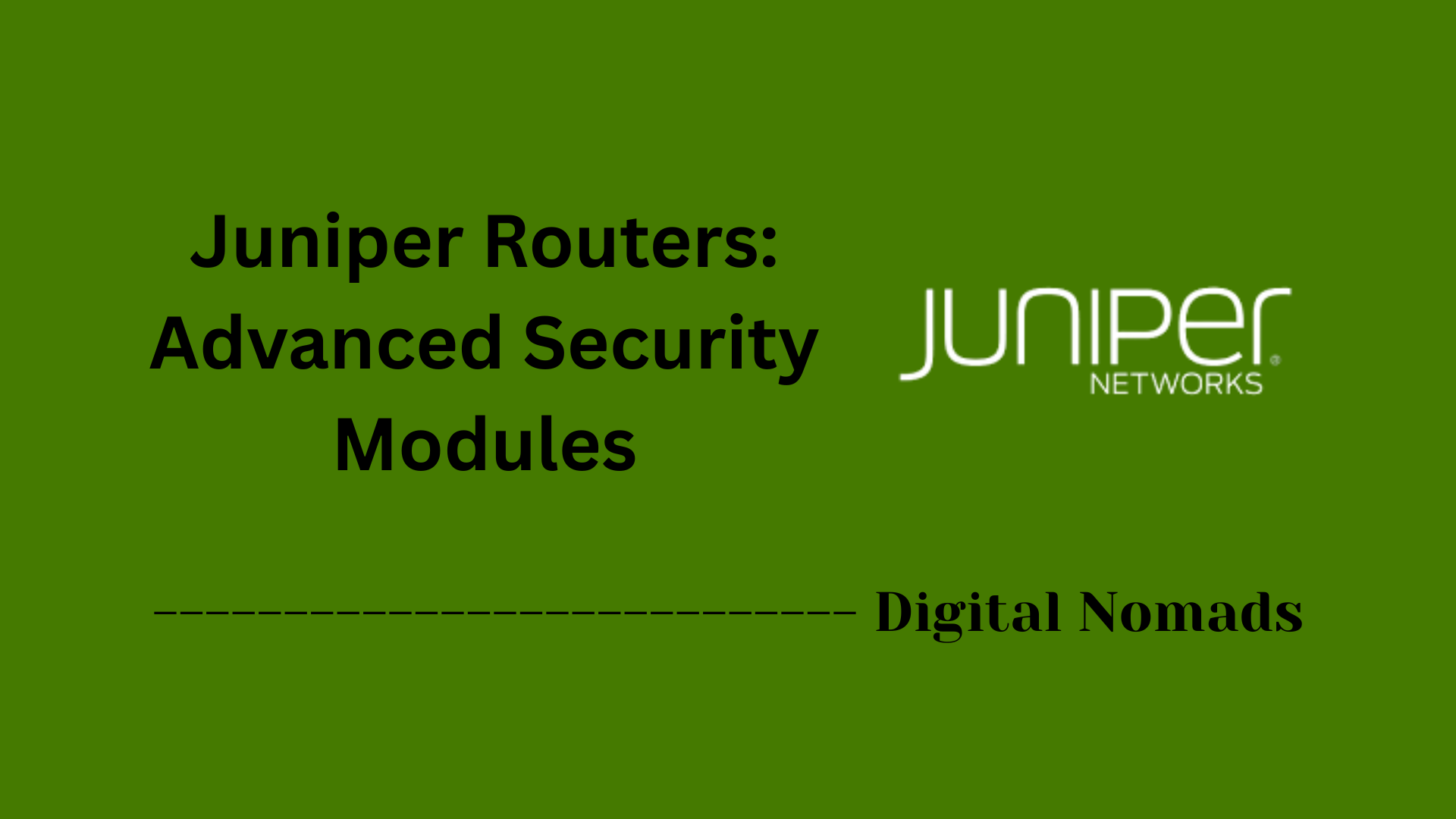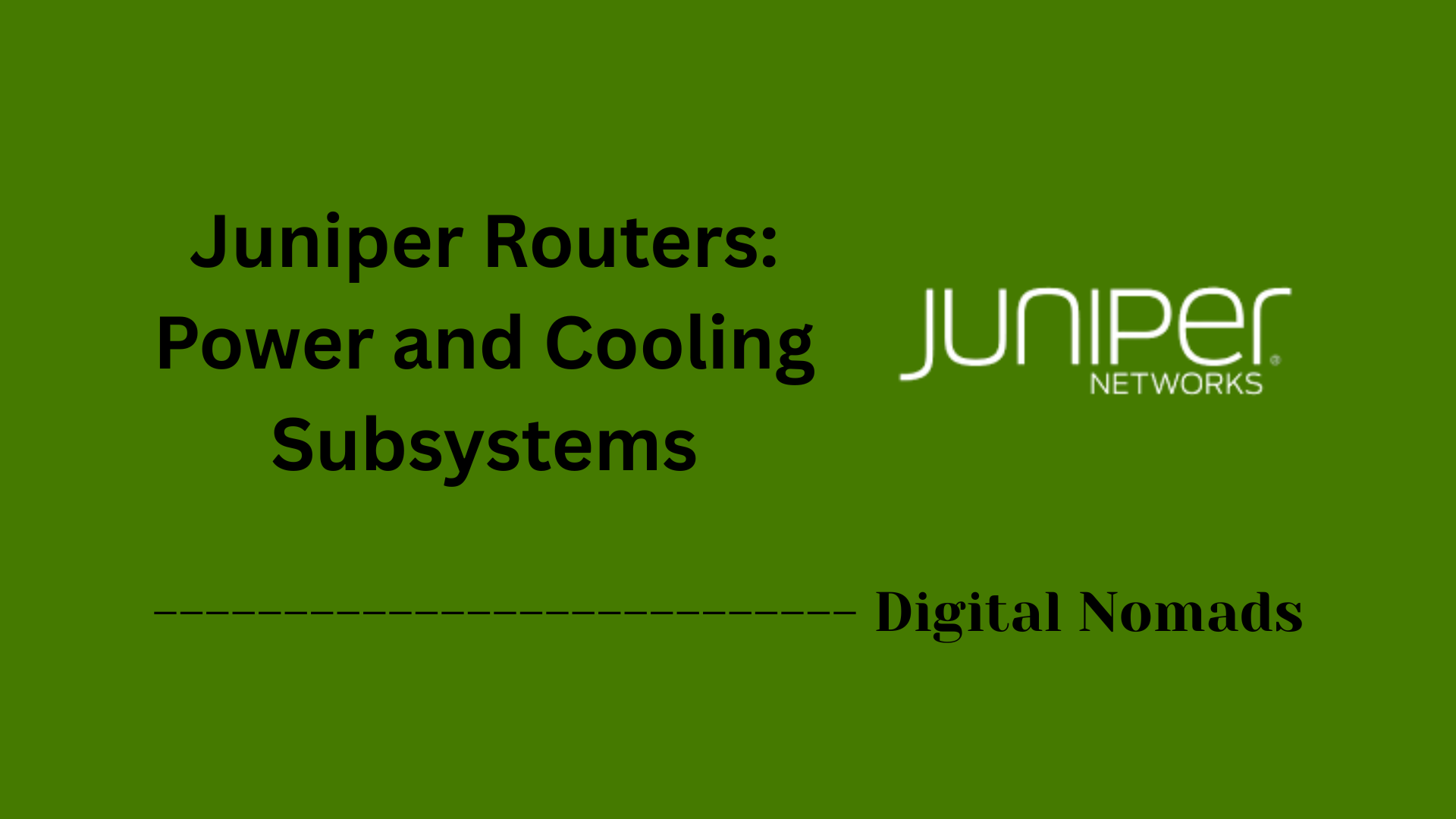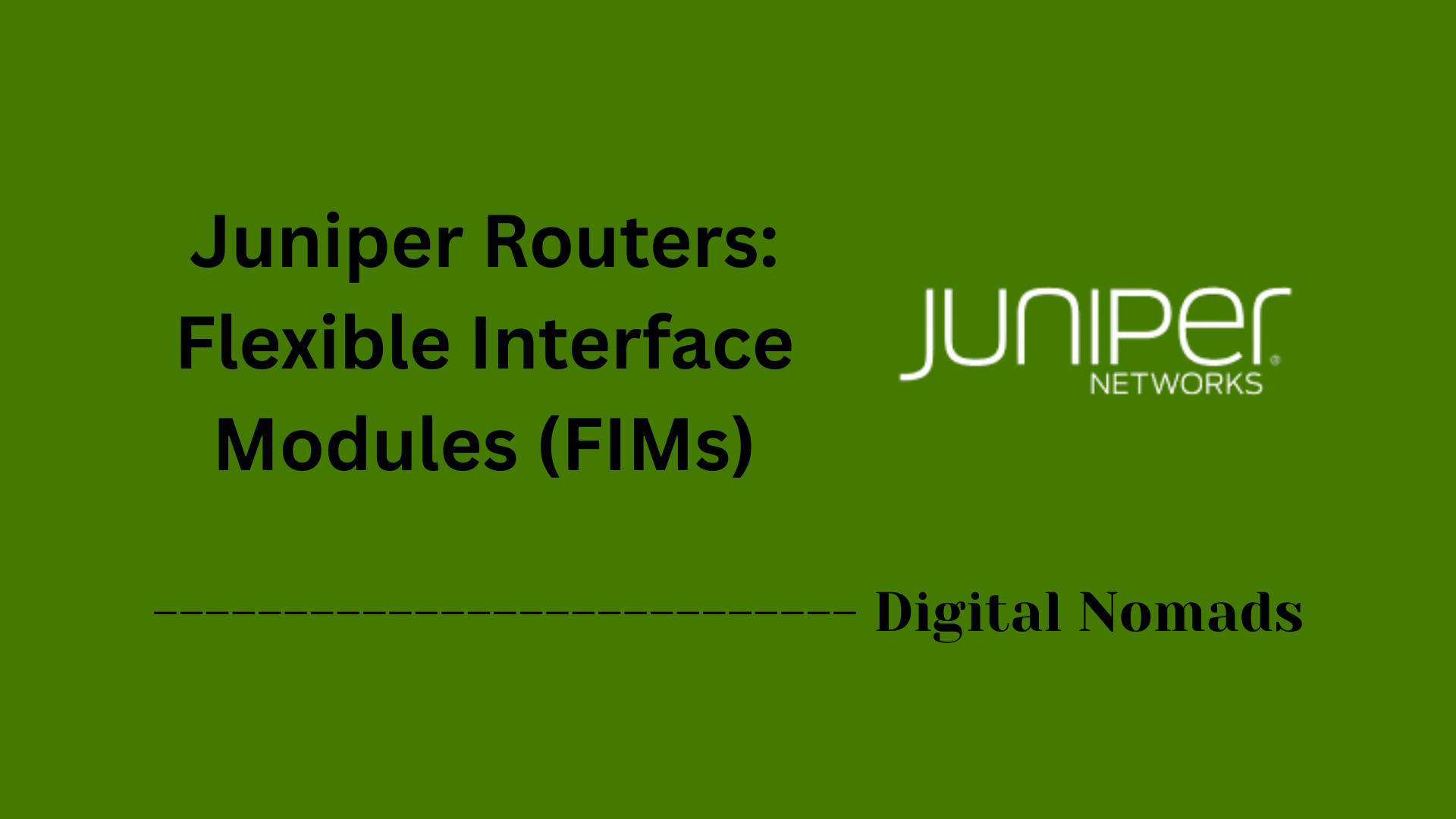Table of Contents
- Overview
- Roles and Functions
- Hardware Architecture
- Security and Protection
- Key Features
- Juniper Routing Engine in Context
- Supported Platforms and Compatibility
- Conclusion
Overview: Juniper Routers – Routing Engine (RE)
What Is the Juniper Routing Engine (RE)?
The Routing Engine (RE) is the core control and management component found in Juniper routers. Often referred to as the “brain” of the device, it is responsible for all centralized decision-making processes that drive the network’s operation. The RE is separate from the forwarding hardware, ensuring that control and management functions run smoothly, independent of high-speed packet processing.
Why Do You Need to Know About the RE?
Understanding the Routing Engine is crucial for anyone managing or designing Juniper-based networks because:
- Network Stability: It oversees routing protocols and system management, directly impacting overall network reliability.
- System Management: The RE is the main access point for configuring, monitoring, and troubleshooting the router.
- Security: Its architecture includes strict access controls and separation from the data plane, ensuring that management functions remain secure and that data forwarding isn’t disrupted by control plane issues.
- Scalability and Redundancy: Knowledge of RE redundancy options helps in designing networks with high availability and failover capabilities.
- Compatibility: Identifying the right RE variant is essential for hardware and software compatibility across various Juniper platforms.
How Does the Routing Engine Work?
- Centralized Control Plane: The RE runs the Junos OS, executing routing protocol processes (like OSPF, BGP, IS-IS), maintaining routing tables, and handling system management operations.
- Separation from Forwarding Plane: High-speed data traffic is handled separately by the Packet Forwarding Engine (PFE), so routing decisions and management tasks by the RE do not impact actual packet forwarding performance.
- Routing Table Management: The RE collects and processes all route information, determines the best paths, and communicates active routes to the PFE for quick lookup and forwarding.
- Interface & Chassis Oversight: It monitors the condition and status of interfaces and the router chassis, manages alarms, and keeps an eye on overall system health.
- Redundancy & Resilience: Many Juniper platforms allow for dual REs, providing seamless failover and enhancing service availability if the primary RE encounters an issue.
In summary, the Routing Engine is at the heart of every Juniper router’s intelligence and resilience, making it essential knowledge for anyone aiming to build, operate, or secure robust network infrastructures.
Roles and Functions of the Juniper Routing Engine (RE)
The Routing Engine (RE) is at the heart of the control plane in Juniper routers. Here are its key roles and functions, broken down step-by-step for clarity:
-
Central System Control:
The RE manages all system operations, including device configuration, interface status reporting, and system management tasks. -
Protocol Processing:
It runs the core routing protocol processes (such as OSPF, BGP, IS-IS), handling route information exchanges and decision-making. -
Routing and Forwarding Table Maintenance:
- Routing Table: Maintains a comprehensive record of all learned routes from various protocols and sources.
- Forwarding Table: Filters the routing table for active routes and passes them to the Packet Forwarding Engine (PFE) for high-speed data forwarding. -
Interface and Chassis Management:
Controls network interfaces, monitors alarms, and oversees chassis health, ensuring the physical router operates smoothly. -
User Access and Management:
Hosts the Command-Line Interface (CLI) and J-Web UI, providing secure access points for administrators to configure and monitor the router. -
Software Storage and Upgrades:
Stores Junos OS images and configuration files and supports routine upgrades for system software and security.
Hardware Architecture of the Juniper Routing Engine (RE)
The Routing Engine (RE) in Juniper routers is architected for maximum reliability, performance, and modular operation. Here’s a step-by-step breakdown of its hardware architecture:
-
General-Purpose Computer Platform:
The RE operates on x86 or PowerPC architectures, depending on the router model and generation, functioning as a robust control module within the chassis[4][5]. -
Separation of Control and Forwarding:
The RE is dedicated to the control plane—processing routing protocols, managing system operations, maintaining routing/forwarding tables, and providing management access. Packet forwarding happens on the Packet Forwarding Engine (PFE), which uses purpose-built ASICs for high-speed performance[1][5]. -
Redundancy and Hot-Swappability:
Many Juniper routing platforms offer dual, independent REs (primary and backup) that support redundancy and failover. This configuration enables near-zero downtime and high availability as the backup RE can instantly take over if the primary fails[6][12]. -
Storage Subsystems:
The RE typically includes both primary and secondary storage, such as CompactFlash, SSD, or hard disks, to house the Junos OS, configuration files, and backup boot images[6]. -
System Management Interfaces:
The RE provides physical connections for out-of-band management, including console ports, management Ethernet, and USB interfaces for local operations and recovery[5]. -
Modular Software and Process Isolation:
Processes running on the RE are modular, ensuring that the failure of one process does not disrupt others. The underlying system kernel maintains communication with the PFE, ensuring forwarding tables remain synchronized[1][5]. -
Chassis-Level Health and Monitoring:
The RE actively monitors hardware status, generates system alarms, and controls the router’s chassis operations to ensure overall system stability and reliability[1][5].
Security and Protection of the Juniper Routing Engine (RE)
The Routing Engine (RE) in Juniper routers is designed with robust security and protection mechanisms to safeguard network control and management functions. Here’s a step-by-step outline of its key security and protection features:
-
Traffic Filtering and Firewall Protections:
The RE uses firewall filters, typically applied to the loopback (lo0) interface, to ensure only trusted management and protocol traffic can reach the control plane. This blocks unauthorized or malicious traffic from accessing or disrupting the RE’s functions[2][5][8]. -
Authentication and Protocol Security:
Critical routing protocols (BGP, OSPF, IS-IS, etc.) support message authentication using algorithms like HMAC-MD5, ensuring only legitimate routing updates are accepted and reducing the risk of spoofed or corrupted messages[3][13]. -
Access Control and Role-Based Management:
The RE enforces strict access controls via role-based permissions. Roles such as User, Crypto-Officer, and RE-to-RE (for redundancy) define allowed services, with permissions for tasks such as configuration, monitoring, and secure image loading[6]. -
Encrypted Management Access:
Management access is protected by encrypting sessions over SSH or secure console interfaces. Only trusted systems are granted access, minimizing exposure to brute-force or unauthorized login attempts[6]. -
Protection Against Denial-of-Service (DoS) Attacks:
Rate-limiting filters and control plane protection mechanisms are employed to defend the RE against DoS and flood attacks. Traffic to the RE is policed and logged as needed to prevent overload and ensure service availability[7][8][13]. -
Redundancy and Secure Communications:
Communication between redundant REs is secured using protocols like IPsec, supporting high availability and secure failover. This ensures the backup RE can take over control without security compromise if the primary RE fails[6].
Key Features of the Juniper Routing Engine (RE)
The Juniper Routing Engine (RE) stands out as the control center of the router, designed for high performance, reliability, and operational flexibility. Below is a step-by-step overview of its key features:
-
Dedicated Control Plane Architecture:
Operates independently from the data plane, enabling fault tolerance and uninterrupted packet forwarding even if the control plane encounters issues[1][6]. -
Comprehensive Table Management:
Maintains multiple essential tables:- Routing Table: Contains all known routes, both active and inactive, as learned from all protocols and sources[1][7].
- Forwarding Table: Consists only of active routes; provides efficient route lookups for high-speed traffic forwarding[4][6].
- Bridging Table: Manages Layer 2 entries for switching and bridging functions[6][7].
-
Robust Operating System:
Runs Junos OS with modular processes for routing, management, and security; each process operates in its own protected memory space for system stability[2][6]. -
Interface and Chassis Control:
Oversees the status and operations of all interfaces and chassis components. Responsible for physical health monitoring and alarm generation[1][6]. -
User Access and Management:
Provides both Command-Line Interface (CLI) and web-based (J-Web) management options, securing and simplifying device configuration and troubleshooting[1][2]. -
Redundancy and High Availability:
Supports deployment of redundant Routing Engines for seamless failover and service continuity in critical environments[4]. -
Modular Software Upgrades:
Software upgrades and maintenance tasks are performed on the Routing Engine, supporting flexibility and reducing downtime during upgrades[4]. -
Security Features:
Enforces access controls, supports encrypted management (SSH), role-based permissions, and protocol authentication to protect against unauthorized access and attacks[7].
Juniper Routing Engine in Context
The Routing Engine (RE) is essential to the architecture and reliability of Juniper routers. This section outlines its real-world context and integration with other system components using a step-by-step approach:
-
Separation of Control and Data Planes:
The RE is dedicated to the control plane, responsible for managing routing decisions, protocols, and device management. Meanwhile, the Packet Forwarding Engine (PFE) handles high-speed transit (user) traffic, using specialized hardware for efficiency. This physical and logical separation ensures that issues on the control plane (such as management failures or crashes) do not affect the ongoing data forwarding through the router[1][6][15]. -
System Resilience and Reliability:
Juniper’s architecture allows the router to continue forwarding packets even if access to the CLI or management services (handled by the RE) is interrupted. This leads to greater system uptime compared to platforms where control and data functions are intertwined[1][15]. -
Routing Decision and Table Distribution:
The RE gathers all route information (from dynamic protocols and static entries) in its routing table, then selects the best (active) routes for the forwarding table. The PFE receives the finalized forwarding table to execute rapid lookups for each packet crossing the network[1][4][12]. -
Chassis and Device Management:
Beyond routing, the RE manages the router’s hardware environment—monitoring chassis health, temperature, fans, alarms, and maintaining system logs. It updates the PFE and other hardware modules as needed, ensuring complete system integrity[1][15]. -
Redundancy and High Availability:
On platforms supporting dual REs, one acts as primary, the other as backup. If the active RE fails, the backup takes over seamlessly, providing high availability for mission-critical deployments[3][15]. -
Exception Handling:
Any exception traffic (such as routing protocol packets or management access) not handled by the PFE is escalated to the RE over secure internal links, maintaining clear boundaries between routine transit and control tasks[9][15]. -
Operational Impact:
The architecture ensures that configuration, monitoring, and routing decisions can be handled independently of traffic forwarding, maximizing network resilience even during system upgrades, failovers, or management interface interruptions[1][3][15].
Supported Platforms and Compatibility of the Juniper Routing Engine (RE)
The Juniper Routing Engine (RE) offers wide compatibility across Juniper's enterprise and service provider product lines. Here’s a step-by-step breakdown of supported platforms and key compatibility notes:
-
M Series Routers:
Supported on models like M7i, M10i, M40e, and others. Different Routing Engine variants (such as RE-400, RE-850, RE-B-1800) are tailored for each chassis, often with restrictions on Junos OS version support (e.g., 32-bit only for older models)[1][5]. -
MX Series Routers:
Widely supported across platforms like MX5, MX10, MX40, MX80, MX104, MX204, MX240, MX480, MX960, MX2008, MX2010, and MX2020. Some routers have built-in REs, while others (like MX240/480/960) support modular NG-REs (Next-Generation Routing Engines) such as RE-S-X6-64G and RE-S-X6-128G. These support both 32-bit and 64-bit Junos OS, depending on the model and hardware version[1][2][5]. -
T Series Routers:
Platforms like T640, T1600, and T4000 support dedicated Routing Engines such as RE-DUO-C1800, with compatibility mapped to specific hardware part numbers and Junos OS versions[5]. -
EX and QFX Series Switches:
EX9200 series switches utilize EX9200-RE (Routing Engine module) for management and control functions. Some QFX platforms also integrate routing engine functionality for highly flexible deployments[5]. -
PTX Series Packet Transport Routers:
Large-scale PTX routers use dedicated Routing Engines (e.g., RE-PTX-X8-64G) designed for ultra-high-performance mission critical networking[2][5]. -
Chassis and Software Notes:
Compatibility is model-specific—each router or switch must use routing engines certified and supported for its chassis. Newer models often support both 32-bit and 64-bit Junos images; next-generation REs run on x86 or PowerPC and offer enhancements for redundancy, scale, and VM-hosted Junos versions[1][5].
| Platform Series | Example Models | RE Type/Model | Notes |
|---|---|---|---|
| M Series | M7i, M10i, M40e | RE-400, RE-850, RE-B-1800 | Older hardware, typically 32-bit OS support |
| MX Series | MX240, MX480, MX960, MX104, MX204, MX2008, MX304, MX2020 | RE-S-X6, RE-MX104, JNP304-RE-S, REMX2008-X8, Built-in RE | Both modular and built-in REs; 32/64-bit OS |
| T Series | T640, T1600, T4000 | RE-DUO-C1800 | Specifically matched to chassis |
| EX Series | EX9200 | EX9200-RE | Switches with RE management module |
| PTX Series | PTX3000, PTX5000, PTX10000 | RE-PTX-X8-64G, RCB-PTX | Carrier-class platforms, specialized REs |
Tip: Always consult Juniper’s official compatibility matrix for specific model/RE and software release details, especially when planning upgrades or replacements. Using the right RE ensures supported features, redundancy, and full software compatibility with your Juniper platform[1][2][5].
Conclusion
As we wrap up our deep dive into the Juniper Routing Engine (RE), it’s clear that this component serves as the vital control center of Juniper routers, orchestrating everything from routing protocols and system management to security and fault tolerance. By separating the control plane from the forwarding plane, the RE not only ensures high-performance packet processing but also enhances network reliability and scalability.
Key takeaways include the RE’s modular hardware architecture designed for redundancy and hot-swappability, robust security measures protecting routing information and management access, and its critical role in maintaining routing and forwarding tables that drive efficient data transport. Additionally, its compatibility across a broad range of Juniper platforms—from M and MX series routers to PTX and EX switches—makes it a versatile and indispensable part of network infrastructures.
We hope this blog post has provided you with a clearer understanding of the Juniper Routing Engine’s important role and capabilities. If you're managing or designing Juniper networks, keeping the RE’s functions and features in mind can help you optimize performance and ensure robust network operations.
Thanks for reading, and stay tuned for more insights on networking technologies!




